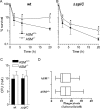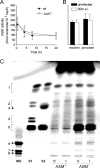Constitutive acid sphingomyelinase enhances early and late macrophage killing of Salmonella enterica serovar Typhimurium
- PMID: 17698574
- PMCID: PMC2168317
- DOI: 10.1128/IAI.00689-07
Constitutive acid sphingomyelinase enhances early and late macrophage killing of Salmonella enterica serovar Typhimurium
Abstract
We have identified acid sphingomyelinase (ASM) as an important player in the early and late anti-Salmonella activity of macrophages. A functional ASM participated in the killing activity of macrophages against wild-type Salmonella enterica serovar Typhimurium. The role of ASM in early macrophage killing of Salmonella appears to be linked to an active NADPH phagocyte oxidase enzymatic complex, since the flavoprotein inhibitor diphenyleneiodonium not only blocked a productive respiratory burst but also abrogated the survival advantage of Salmonella in macrophages lacking ASM. Lack of ASM activity also increased the intracellular survival of an isogenic DeltaspiC::FRT Salmonella strain deficient in a translocator and effector of the Salmonella pathogenicity island 2 (SPI2) type III secretion system, suggesting that the antimicrobial activity associated with ASM is manifested regardless of the SPI2 status of the bacteria. Constitutively expressed ASM is responsible for the role that this lipid-metabolizing hydrolase plays in the innate host defense of macrophages against Salmonella. Accordingly, the ASM activity and intracellular concentration and composition of ceramide, gangliosides, and neutral sphingolipids did not increase upon Salmonella infection. Salmonella triggered, nonetheless, a significant increase in the secreted fraction of ASM. Collectively, these findings have elucidated a novel role for constitutive ASM in the anti-Salmonella activity of murine macrophages.
Figures






Similar articles
-
Induction of antimicrobial pathways during early-phase immune response to Salmonella spp. in murine macrophages: gamma interferon (IFN-gamma) and upregulation of IFN-gamma receptor alpha expression are required for NADPH phagocytic oxidase gp91-stimulated oxidative burst and control of virulent Salmonella spp.Infect Immun. 2003 Aug;71(8):4733-41. doi: 10.1128/IAI.71.8.4733-4741.2003. Infect Immun. 2003. PMID: 12874355 Free PMC article.
-
Acid Sphingomyelinase Contributes to the Control of Mycobacterial Infection via a Signaling Cascade Leading from Reactive Oxygen Species to Cathepsin D.Cells. 2020 Nov 3;9(11):2406. doi: 10.3390/cells9112406. Cells. 2020. PMID: 33153072 Free PMC article.
-
The LysR-type transcriptional regulator Hrg counteracts phagocyte oxidative burst and imparts survival advantage to Salmonella enterica serovar Typhimurium.Microbiology (Reading). 2008 Sep;154(Pt 9):2837-2846. doi: 10.1099/mic.0.2008/017574-0. Microbiology (Reading). 2008. PMID: 18757817
-
Codependent and independent effects of nitric oxide-mediated suppression of PhoPQ and Salmonella pathogenicity island 2 on intracellular Salmonella enterica serovar typhimurium survival.Infect Immun. 2009 Nov;77(11):5107-15. doi: 10.1128/IAI.00759-09. Epub 2009 Sep 8. Infect Immun. 2009. PMID: 19737903 Free PMC article.
-
Salmonella evasion of the NADPH phagocyte oxidase.Microbes Infect. 2001 Nov-Dec;3(14-15):1313-20. doi: 10.1016/s1286-4579(01)01492-7. Microbes Infect. 2001. PMID: 11755420 Review.
Cited by
-
The unexpected role of acid sphingomyelinase in cell death and the pathophysiology of common diseases.FASEB J. 2008 Oct;22(10):3419-31. doi: 10.1096/fj.08-108043. Epub 2008 Jun 20. FASEB J. 2008. PMID: 18567738 Free PMC article. Review.
-
Macrophage-Bacteria Interactions-A Lipid-Centric Relationship.Front Immunol. 2017 Dec 20;8:1836. doi: 10.3389/fimmu.2017.01836. eCollection 2017. Front Immunol. 2017. PMID: 29326713 Free PMC article. Review.
-
Secretory sphingomyelinase (S-SMase) activity is elevated in patients with rheumatoid arthritis.Clin Rheumatol. 2018 May;37(5):1395-1399. doi: 10.1007/s10067-017-3824-1. Epub 2017 Sep 15. Clin Rheumatol. 2018. PMID: 28914380 Free PMC article.
-
The critical roles of bioactive sphingolipids in inflammation.J Biol Chem. 2025 Jul 11;301(8):110475. doi: 10.1016/j.jbc.2025.110475. Online ahead of print. J Biol Chem. 2025. PMID: 40653199 Free PMC article. Review.
-
Regulated secretion of acid sphingomyelinase: implications for selectivity of ceramide formation.J Biol Chem. 2010 Nov 12;285(46):35706-18. doi: 10.1074/jbc.M110.125609. Epub 2010 Aug 31. J Biol Chem. 2010. PMID: 20807762 Free PMC article.
References
-
- Cirillo, D. M., R. H. Valdivia, D. M. Monack, and S. Falkow. 1998. Macrophage-dependent induction of the Salmonella pathogenicity island 2 type III secretion system and its role in intracellular survival. Mol. Microbiol. 30:175-188. - PubMed
-
- De Groote, M. A., U. A. Ochsner, M. U. Shiloh, C. Nathan, J. M. McCord, M. C. Dinauer, S. J. Libby, A. Vazquez-Torres, Y. Xu, and F. C. Fang. 1997. Periplasmic superoxide dismutase protects Salmonella from products of phagocyte NADPH-oxidase and nitric oxide synthase. Proc. Natl. Acad. Sci. USA 94:13997-14001. - PMC - PubMed
Publication types
MeSH terms
Substances
Grants and funding
LinkOut - more resources
Full Text Sources
Miscellaneous

